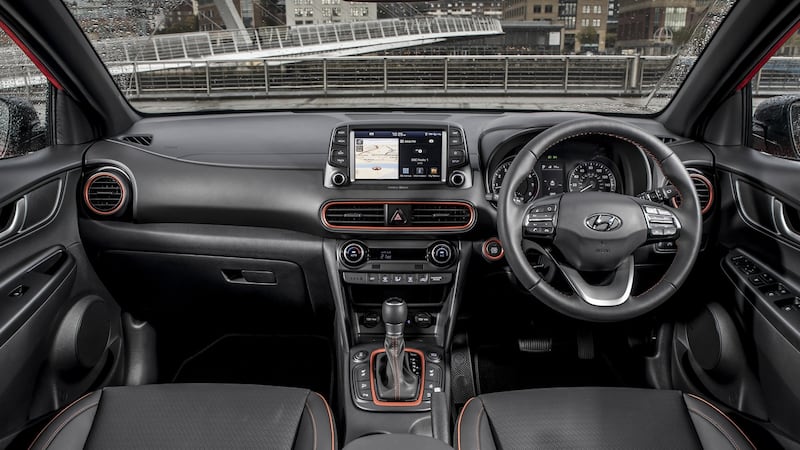Hyundai’s on a roll at present. Having firmly established itself as a top tier player in the Irish market, the Korean brand is rapidly expanding its range. The latest new arrival is the Kona, a family hatchback-sized crossover that’s right on the money in terms of consumer appetite.
New car buyers want butch off-road looks at a price point that’s not too far north of the regular hatchback. The fact that these cars offer little in the way of real SUV ability and are often less spacious than a “regular” hatchback, doesn’t seem to matter a jot to buyers. The recipe is simple: hoist your latest supermini off the ground by a few more millimetres, stick some plastic protection strips along the wheel arches and start taking orders.
Given the strength of the Hyundai brand in Ireland at present, it's a pretty safe bet to assume this car will feature in the top five best-sellers in 2018. But how does it stack up to the ever-growing car park of rivals?


First up on styling, the Kona is a winner. After years of being in the shadow of its sister brand Kia when it came to design, Hyundai can now boast the best looking car in its range. That's largely down to the leadership of car design guru Peter Schreyer. The creative brain behind the Audi TT, he was styling Kias for several years before being called upon to work his magic on the parent brand as well. The move has paid off. The Kona is a great looking car.
Inside, things get a little more underwhelming. Even on the top-level Premium specification, black plastic is the dominant theme. It’s an ongoing weakness for the Korean brand: it really needs to up its game on the interior trim. However, there’s ample tech for the price and the 7-inch touchscreen that’s standard on Executive and Premium versions is on a par with any rival.
Comfortable
It’s easy to get comfortable in the Kona and the rear seats are surprisingly spacious for a car that measures in 100mm shorter than the i30 hatchback. However, the bootspace is relatively small at 361 litres (1,143 litres with the rear seats down). The i30 hatch, for example, has 378 litres.
Overall, the Kona’s interior doesn’t match the standard set by its Asian rival, the Toyota C-HR.

The Kona drives well, with the steering offering good feedback at normal speeds. Get a bit aggressive with it and up the pace, then it does start to feel more vague, but it's more engaging than the Tucson in this regard. The car feels as nimble as it should for its size, and while it doesn't match a proper supermini in terms of cornering, it's still much better than expected. The ride is comfortable, if a little firm on badly surfaced roads.
The Kona comes in two engine flavours: a 1-litre or 1.6-litre petrol. Later in the year a 1.6-litre diesel is due, along with promises of an electric version.
Our test car was the more powerful petrol, putting out 175bhp and complete with all-wheel drive and dual-clutch auto. However, this is not a fast car, even with a claim of a 0-100km/h time of 7.9 seconds. That’s partly down to weight. The 1.6-litre adds 200kgs to the car over the 1-litre. .
Perhaps it was the sluggish response from the engine, but the auto box is also too sedate for this car and despite a dual-clutch format that usually manages to maintain power at the sweet-spot in the rev range, this particular engine and transmission combination never feels to be in sync. It seems slow to respond and also results in more high-rev engine noise than is really necessary.

All-wheel drive
Despite the lower output – 120bhp – and a seemingly snail’s pace official 0-100km/h time of 12 seconds, the 1-litre with manual transmission seems the better option. The weight-saving will make up for the power. It will also save you €190 a year on motor tax, due to lower emissions. And let’s face it, Kona buyers will not be prioritising performance on their shopping list. Neither will they really be looking for all-wheel drive.
There are more savings to be had by getting your specifications right. We had the Premium level trim, but in truth the additional extras of leather seats and park assist don’t really warrant the extra spend. Opt for the 1-litre in Executive trim and you get most of the digital touches, but for €3,000 less than the 1.6-litre Premium manual version, and €5,000 less than the automatic.
While there’s a fleet of Kona rivals arriving on the market at present, the Hyundai can certainly hold its own, given the mix of styling and with prices starting at €20,995. It’s a better drive than the recently launched Opel Crossland X, though it faces stiff competition from the new Seat Arona. As you move up the price range it starts to come up against rivals like the Toyota C-HR, which starts at €26,895. But the Kona’s price will lure buyers to the Korean brand. And that should see the Kona follow closely in the tyre tracks of its sibling, the Tucson, currently Ireland’s best-selling car.
Lowdown: Hyundai Kona 1.6 Premium DCT
Engine: 1,591cc four cylinder in-line putting out 175bhp @ 5,500rpm and 265Nm of torque
0-100km/h: 7.9 secs
L/100km (mpg): 6.7 (42.2)
Emissions (motor tax): 153g/km (€390)
Price: €29,995 for auto (starts at €20,995 for the 1-litre petrol)
Our rating: 3/5
Verdict: Another surefire sales success for the Korean brand.












